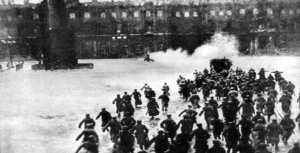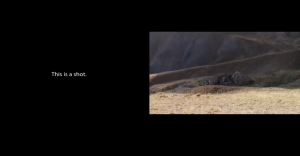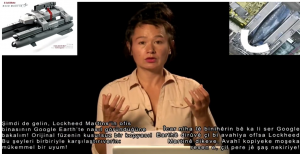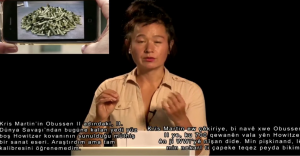
The Museum As Battlefield – The Case Of Hito Steyerl, Part 2 (Wigbertson Julian Isenia)
The following is the second of a two-part series. The first installment can be found here.
The museum as a public space
What is the public in a contemporary context? How is this idea of the public constructed historically and how can we analyze it from its perspective of its geopolitics? Also, how can the public defined in the light of the current events in Turkey? How do these events affect the way we think about being public ourselves, and the public these events want to address?
A public is a prerequisite to the work of art, an art space or festival, if it wishes to function fully aesthetically or politically and have a substantial dialogue between maker and viewer, and between curator and the curated. As Andrea Phillips notes in her lecture, since the curatorial program circles around public and public domain, the curated is the viewer or the inhabitants or user of the space.
Further, in Boris Groys’ book On the New, he discusses a public’s relationship between a museum as a constructor and life. According to the website, Istanbul Foundation for Culture and Arts, art in that sense makes public, a group of “bodies acting together to claim space.” This idea becomes interesting when it is reshaped and rethought “in order to make the relationship, between the cultural producers and the people that are called the public, more equitable.”
However, the relationship between creator and viewer had always been skewed, which is also the case here. The creator acts as a representative of a certain group that seems to have no voice, and speaks on behalf of the denoted group. As co-curator of the 13th Istanbul Biennial, Andrea Philips, Reader in Fine Art in the Department of Art, Goldsmiths, the University of London, and Director of the Doctoral Research Programs in Fine Art and Curating, points out in her lecture: “the unwitting well-meaning ethos of the programmer dictates a benign hierarchy of subjective and social power over the programmed.”
What if the public rejects the present it gets, in this case, a public debate—as was the case at the 13th Istanbul Biennial? How can an art space react to this antagonism? This present dilemma is thoroughly addressed in the work ‘Is the museum a battlefield?’ (2012) by the German artist Hito Steyerl (Munich, 1966), that was also presented at the exhibition of the 13th Istanbul Biennial. In the following part of this essay, I will develop the notion of public—a body of people—and the public realm—a physical or virtual space, which is used or inhabited by the public—to address the issues raised in this particular artwork and the context that it is embedded.
The museum as a battlefield
This 32-minute-long performance video lecture is now accessible via the video- sharing website Vimeo, and evolves on the congruity between the sponsors of the 13th Istanbul Biennial and the arms trade. Steyerl, a critically acclaimed artist, doctor of philosophy, and professor of new media art in Berlin received a lot of recognition and attention for this particular artwork.
Currently, a mid-career retrospective of Steyerl is taking place in the van Abbemuseum in Eindhoven. Steyerl’s work can perhaps be framed within the intersection of art and activism, where Begüm Özden Firat and Aylin Kuryel discuss in Cultural Activism: Practices, Dilemmas, and Possibilities how contemporary art groups aim to bring about “societal transformation within the broader framework of contemporary anti-capitalist, anti-consumerist, and alternative-globalization struggles” (10).
We begin to understand how artworks can be critical within an established and secluded art space, in this case, a museum. Through critical analysis of the artwork ‘Is the Museum a Battlefield?’ we discover how the artist, Hito Steyerl, interlaces the mixture between art and activism in the public realm. Furthermore, we may relate this analysis to contemporary theoretical debates and modes of framing these forms of activist art.
As the opening credits state, the artwork, commissioned by the 13th Istanbul Biennial, Public Program and Stedelijk Museum Amsterdam, opens with the titular question: “ss the museum a battlefield?” Steyerl, who herself is the protagonist in all her films, begins the lecture by testing the validity of her proposition by playing the devil’s advocate. She says that most will ask “how could such a so secluded and isolated place, [as the museum is], be a battlefield, and of what battle?”
However, she then reminds us that throughout history, museums have been very much battlefields as sites of torture chambers, war crimes, civil wars and revolutions. She gives the example of the attack and the storming in 1917 of the Hermitage Museum in the Winter Palace (St Petersburg, Russia) led by the Bolshevik. As she picks up on this event, you get to see a fragment of the film October (1928) by Sergei Eisenstein. (Picture 1)
We might ask, though, if we can relate these events to the present. According to Steyerl, the situation nowadays is much less different that one might expect
The feudal art collections were established by wealthy patrons and aristocrats who put their wealth and taste on display. Today art spaces worldwide, in emerging countries just as in former metropoles, are shifting back, or rather forward to feudal modes, again, turning into flagships displays of oligarch wealth and bubble money. Is the battle inside the museum; is the revolution, in itself, […] a prelude to all-out gentrification?

The question raised at the outset—Is the Museum a Battlefield?—can also be seen from a different perspective. Namely, does a battlefield have characteristics that can commensurate with contemporary art spaces or museums, and what may this battlefield then look like? At this point, the lecture performance suddenly takes a different form. What at first started as a stiff, rehearsed reading in front of a black background with a slideshow presentation (picture 2), becomes a documentary-style sequence where Steyerl visits an actual battlefield.
This particular battlefield is a battleground near Van in southeast Turkey, where a friend of Steyerl, Andrea Wolf, a former member of the women’s section of the ‘Partiya Karkerên Kurdistan’ (Kurdistan Workers’ Party)

(PKK), was killed in 1998. At the beginning of this sequence, we hear a loud shot, presumably of a missile thatwas fired, and we only get to see a mountainous landscape, with the sentence: “this is a shot” (picture 2).
Directly following this, there is another two-channel shot, with again a mountainous landscape, and now the sentence “this is an interview” (picture 3).
In the interview, a man explains how ten to fifteen Cobra helicopters came to the site and killed 39 of the PKK fighters. Because this event was never thoroughly investigated or clarified, probably due to the still ongoing conflict between the Turkish government and the PKK movement, Steyerl went there herself with a couple of colleagues and friends to investigate what exactly

happened. Upon arrival, they encountered a very small and mundane battlefield with the remaining clothes and scarves from the women on the ground. Among these objects, Steyerl found a 20mm ammunition case fired by one of the Cobra helicopters. This ammunition case is the starting point of her quest to find the inception of this weapon.
In her quest, she found out that architects, designers, and artists use the same CAD software, a computer-aided design program, which is being used by the arms trade industry to make their weapons and surveillance mechanisms. Moreover, Steyerl shows that several artworks or buildings have in their form, similarities with weapons or missiles (picture 4), or explicitly refer to them (picture 5).

In addition, many former and current weapon manufacturers, including General Dynamics, Siemens, and Lockheed Martin, are actually art benefactors, allowing the arms trade money to circulate (invisibly) within public institutions and via works of art. By tracking down the origins of the detritus of a 20mm ammunition made by General Dynamics, Steyerl found herself in the Art Institute of Chicago, which is sponsored by General Dynamics, where the artwork of hers, ‘Abstract’ (2012), was installed there. As Steyerl explains:

This artwork was actually showing the battlefield, which, in my logic, originated from that site. I was following the bullet back from the place it came from, and I ended up in a sort of weird feedback loop, as if the bullet was not flying straight, from one point to another, but actually it was flying in a circle. It was flying in a loop and probably killing a lot of people in its way.
By seeing her artwork in a place that is sponsored by a big weapon manufacture, Steyerl has no other choice than to accept her involvement in this matter. The 20mm ammunition case, thus according to Steyerl, “flies in a [vicious] circle,” and by tracing this particular ammunition, the artist might end up with himself, as he is part of a strange loop. Alternatively, by “shooting” an artwork, the artist inadvertently shoots people and perhaps even his friends, due to the “toxic data clouds” in which the artist is somehow intertwined).
Here, Steyerl makes a strong case, although it needs a little bit more attention so that we can fully grasp her argument. In my perception, her argument states that the arms trade make weapons, which equates to more deaths and wars. These wars and deaths are excellent sources of income for these weapon manufacturers, allowing them to make more profit. More profit creates an opportunity to sponsor more cultural events, which give these manufactures uncountable positive publicity, power and money, which in turn produce more weapons.
Rather than withdraw from such spaces because of their connection with military violence and gentrification, “on the contrary, I [will] show this video [art]work in every single art space connected to this battlefield. If there is such feedback loop I could also go ahead and try to change the direction to see which physical affect might happen.” Steyerl recalls the storming of another museum, namely the Louvre (Paris, France) in 1792 during the French Revolutions.
The Louvre was stormed once more in 1830, 1832, 1848, and 1871. Every time during a storming, the common man, according to Steyerl, entered the museum, like he would on the battlefield, to fight for the public space. It took five battles to create, and subsequently, to keep the Louvre a public art museum, which is now free to all students. To have a public space, Steyerl concludes, one has to storm it.
Conclusion,
One might think that the strategy of Steyerl’s project was that of being a Trojan Horse, invading the biennial—and thus the museum—by stealth in order to conquer it. Indeed, the methods of Steyerl fit well within Lucy Lippard’s definition of activist art. In her essay ‘Trojan Horses: Activist Art and Power,’ Lippard delineates activist art as operating “both within and beyond the beleaguered fortress that is high culture or the art world, [and providing] alternative images, metaphors, and information formed with humor, irony, outrage and compassion.”
In her lecture performances, Steyerl uses irony, language and video, as devices to question and understanding reality, by presenting a possible alternative to the status quo. But the most important feature that correlates Steyerl artwork with the text by Lippard is that activist art “has to take into considerations not only the formal mechanisms within art itself, but also how it will reach its context and audience and why (emphasis added).” This sentence will not help answering the question if Steyerl’s project contributed in any way to aid the problems that were going outside on the streets of Turkey at that time.
However, for Steyerl, the only way for the Biennial to be successful or effective, that is, realizing its stipulated aims, is to allow antagonism that opposes the biennial’s very existence. To adequately affect or to effect, make and unmake what is considered public, is to let the biennial be stormed, disrupted and to be the actual battlefield, and thus questioning its own actuality. When people on the streets are psychologically and politically hurt, artists, to quote Lippard, should not function “like a lazy gardener who cuts off the weeds as a temporary holding action.” They should “go under the surface to the causes.” Lippard continues, “social change can [only] happen when you tear things up by the roots, collage metaphors, or when you go back to the roots and distinguish the weeds from the blossoms and vegetables.”
Steyerl in her eloquently delivered charge, should take a step further next time. Instead of asking, “Is the museum a battlefield?” she should bring a water cannon the next time she visits a war zone.
Wigbertson Julian Isenia originates from the Island of Curacao and has an MA degree in Arts and Culture (University of Amsterdam), and two bachelor’s, in interdisciplinary social sciences (University of Utrecht) and Theatre Studies (University of Amsterdam). During his MA, he received a scholarship from Bekker-la Bastide fund and the University of Amsterdam nominated him for the ECHO awards. Currently he is collecting source materials on theatre plays, literature and film, as well as archival research, that seeks to gain an in-depth knowledge of Dutch Caribbean queer lives on the island of Curaçao. This preliminary research in preparation for his PhD is funded by the Sylvia W. de Groot Fund.
Tagged with: Andrea Wolf, Art Institute of Chicago, Begüm Özden Firat, Hito Steyerl, Istanbul Bienneal, Lucy Lippard
